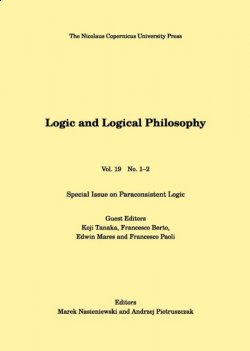The critics of paraconsistency and of many-valuedness and the geometry of oppositions
DOI:
https://doi.org/10.12775/LLP.2010.004Keywords
n-opposition theory, logical poly-simplexes, paraconsistent logic, many-valued logic, trans-Suszkian logic, geometry of opposition, Slater, Priest, Béziau, Suszko, Shramko, WansingAbstract
In 1995 Slater argued both against Priest’s paraconsistent system LP (1979) and against paraconsistency in general, invoking the fundamental opposition relations ruling the classical logical square. Around 2002 Béziau constructed a double defence of paraconsistency (logical and philosophical), relying, in its philosophical part, on Sesmat’s (1951) and Blanche’s (1953) “logical hexagon”, a geometrical, conservative extension of the logical square, and proposing a new (tridimensional) “solid of opposition”, meant to shed new light on the point raised by Slater. By using n-opposition theory (NOT) we analyse Beziau’s anti-Slater move and show both its right intuitions and its technical limits. Moreover, we suggest that Slater’s criticism is much akin to a well-known one by Suszko (1975) against the conceivability of many-valued logics. This last criticism has been addressed by Malinowski (1990) and Shramko and Wansing (2005), who developed a family of tenable logical counter-examples to it: trans-Suszkian systems are radically many-valued. This family of new logics has some strange logical features, essentially: each system has more than one consequence operator. We show that a new, deeper part of the aforementioned geometry of logical oppositions (NOT), the “logical poly-simplexes of dimension m”, generates new logical-geometrical structures, essentially many-valued, which could be a very natural (and intuitive) geometrical counterpart to the “strange”, new, non-Suszkian logics of Malinowski, Shramko and Wansing. By a similar move, the geometry of opposition therefore sheds light both on the foundations of paraconsistent logics and on those of many-valued logics.References
Béziau, J.-Y., “New light on the square of oppositions and its nameless corner”, Logical Investigations 10 (2003): 218–233.
Béziau, J.-Y., “Paraconsistent logic from a modal viewpoint”, Journal of Applied Logic 3 (2005): 7–14.
Béziau, J.-Y., “Paraconsistent logic! (A reply to Slater)”, Sorites 17 (2006).
Béziau, J.-Y., “Adventures in the paraconsistent jungle”, in: J.-Y. Béziau, W.A. Carnielli and D. Gabbay (eds.), Handbook of Paraconsistency, King’s Coledge, London, 2007.
Blanché, R., “Sur l’opposition des concepts”, Theoria 19 (1953).
Blanché, R., Structures intellectuelles. Essai sur l’organisation systématique des oncepts, Vrin, Paris, 1966.
Brown, B., “Yes, Virginia, there really are paraconsistent logics”, Journal of Philosophical Logic 28 (1999): 489–500.
Dutilh Novaes, C., “Contradiction: the real challenge for paraconsistent logic”, in: J.-Y. Béziau, W.A. Carnielli and D. Gabbay (eds.), Handbook of Paraconsistency, King’s College, London, 2007.
Frankowski, S., “p-consequence versus q-consequence”, Bulletin of the Section of Logic 33 (2004): 197–208.
Gardies, J.-L., Essai sur la logique des modalités, PUF, Paris, 1979.
Horn, L., A natural history of negation, UCP, Chicago, 1989.
Malinowski, G., “Towards the concept of logical many-valuedness”, Folia Philosophica 7 (1990): 97–103.
Moretti, A., “Geometry for modalities? Yes. Through n-opposition theory”, in: J.-Y. Béziau, A. Costa-Leite and A. Facchini (eds.), Aspects of Universal Logic, University of Neuchâtel, Neuchâtel, December 2004.
Moretti, A., “A graphical decision procedure and some paraconsistent theorems for the Vasil’evian logic IL2”, in: J.-Y. Béziau, W.A. Carnielli and D. Gabbay (eds.), Handbook of Paraconsistency, King’s College, London, 2007.
Moretti, A., The Geometry of Logical Opposition, PhD Thesis, University of Neuchâtel, Switzerland (March 2009).
Moretti, A., “The geometry of standard deontic logic”, Logica Universalis 3, 1 (2009).
Moretti, A., “A geometrical method for classifying and studying quantifiers and modalities” (draft).
Moretti, A., “Correcting McNamara’s ‘deontic dodecagon for DWE’: through NOT”, submitted to Logique et Analyse.
Paoli, F., “Quine and Slater on paraconsistency and deviance”, Journal of Philosophical Logic 32 (2003): 531–548.
Pellissier, R., “‘Setting’ n-opposition”, Logica Universalis 2 (2008).
Pellissier, R., “2-opposition and the topological hexagon”, in: J.-Y. Béziau and G. Payette (eds.), New perspectives on the square of opposition, Peter Lang, Bern, 2010.
Priest, G., “The logic of paradox”, Journal of Philosophical Logic, 8 (1979): 219–241.
Priest, G., An Introduction to Non-Classical Logic, CUP, Cambridge, 2001.
Restall, G., “Paraconsistent logics!”, Bulletin of the Section of Logic 26 (1997): 156–173.
Sesmat, A., Logique II, Hermann, Paris, 1951.
Shramko, Y., and H. Wansing, “Suszko’s thesis, inferential many-valuedness, and the notion of a logical system”, Studia Logica 88 (2008).
Slater, B.H., “Paraconsistent logics?”, Journal of Philosophical Logic, 24 (1995): 451–454.
Smessaert, H., “On the 3D visualisation of logical relations”, Logica Universalis 3, 2 (2009).
Suszko, R., “Remarks on Łukasiewicz’s three-valued logic”, Bulletin of the Section of Logic 4 (1975): 87–90.
Tsuji, M., “Many-valued logics and Suszko’s thesis revisited”,Studia Logica 60 (1998): 299–309.
Downloads
Published
How to Cite
Issue
Section
Stats
Number of views and downloads: 579
Number of citations: 0







